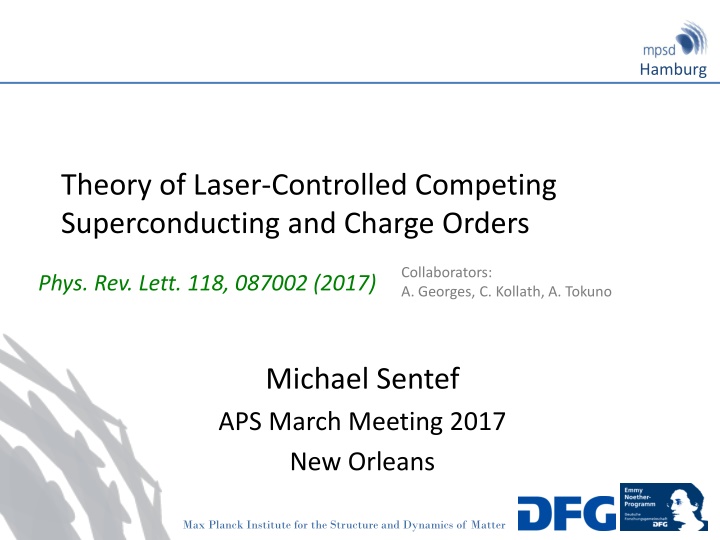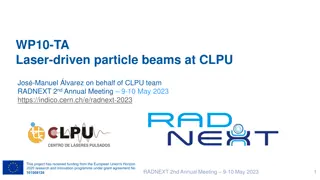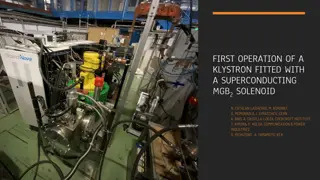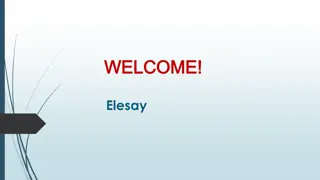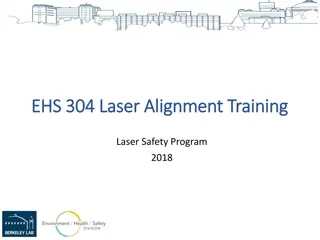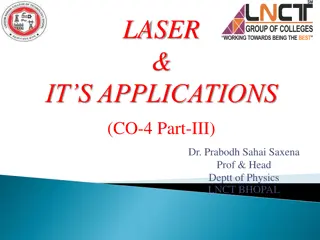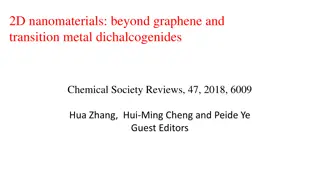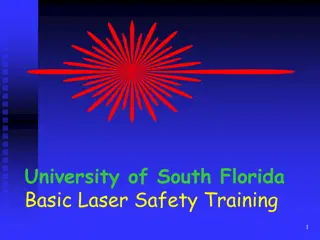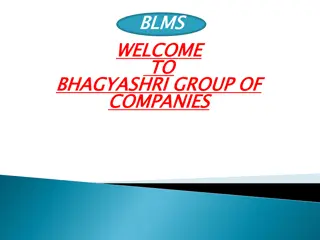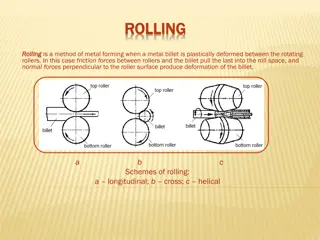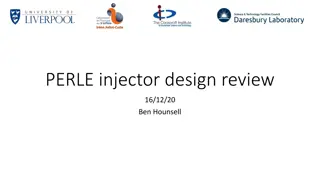Laser-Controlled Competing Superconducting and Charge Orders in Transition Metal Dichalcogenides
Hamburg Theory of laser-controlled competing superconducting and charge orders explores the use of lasers to manipulate the ordering mechanisms in transition metal dichalcogenides, leading to ultrafast switching and the induction of new states of matter. This research delves into generic mechanisms for controlling competing orders with light, involving recent theories and experimental findings on laser-controlled couplings in materials like TMDCs. The study investigates the interplay between superconductivity and charge density waves, driven by laser resonances with collective modes, shedding light on the potential for novel states of matter in condensed systems.
Download Presentation

Please find below an Image/Link to download the presentation.
The content on the website is provided AS IS for your information and personal use only. It may not be sold, licensed, or shared on other websites without obtaining consent from the author.If you encounter any issues during the download, it is possible that the publisher has removed the file from their server.
You are allowed to download the files provided on this website for personal or commercial use, subject to the condition that they are used lawfully. All files are the property of their respective owners.
The content on the website is provided AS IS for your information and personal use only. It may not be sold, licensed, or shared on other websites without obtaining consent from the author.
E N D
Presentation Transcript
Hamburg Theory of Laser-Controlled Competing Superconducting and Charge Orders Collaborators: A. Georges, C. Kollath, A. Tokuno Phys. Rev. Lett. 118, 087002 (2017) Michael Sentef APS March Meeting 2017 New Orleans Max Planck Institute for the Structure and Dynamics of Matter
Nonequilibrium superconductivity Why? - understand ordering mechanisms - control ordered states: ultrafast switching - induce new states of matter How? - laser near resonance with collective modes Generic mechanism to control competing orders with light? Recent theories on laser-controlled couplings and competing orders: Akbari et al., EPL 101, 17003 (2013); Moor et al., PRB 90, 024511 (2014); Fu et al., PRB 90, 024506 (2014); Dzero et al., PRB 91, 214505 (2015); Tsuji&Aoki, PRB 92, 064508 (2015); Cea et al., PRB 93, 180507 (2016); Kemper et al., PRB 92, 224517 (2015); Sentef et al., PRB 93, 144506 (2016); Krull et al., Nat. Commun. 7, 11921 (2016); Patel&Eberlein, PRB 93, 195139 (2016); Knap et al., PRB 94, 214504 (2016); Komnik&Thorwart EPJB 89, 244 (2016); Coulthard et al., 1608.03964; Kennes et al., Nat. Physics (2017), doi:10.1038/nphys4024; Sentef, 1702.00952; Babadi et al. 1702.02531; Murakami et al.,1702.02942; Mazza&Georges, 1702.04675; Dehghani&Mitra, 1703.01621 2 Max Planck Institute for the Structure and Dynamics of Matter
transition metal dichalcogenides (TMDCs) Experimental motivation: competing orders metals/CDWs/superconductors Stripe-ordered LESCO NbSe2 YBCO-LCMO heterostructure doped MoS2 NbSe2 CDW SC A. Frano et al., Nat. Mater. 15, 831 (2016) Science 338, 1193 (2012) D. Fausti et al., Science, 331, 189 (2011) X. Xi et al., Nat. Nanotechnol. 10, 765 (2015) Nat. Nanotechnol. 10, 765 (2015) Stripe-ordered LBCO 12/11/2015 SFB-Workshop "Exotic States of Condensed Matter" 7 D. Nicoletti et al., PRB 90, 100503 (2014) 3 Max Planck Institute for the Structure and Dynamics of Matter Figure 1. (a) Temperature-doping phase diagram of LBCO, as determined in Ref. 7. Tc, TCO, TSO, and TLT indicate the superconducting, charge-order, spin-order, and structural transition temperatures, respectively. Colored circles indicate the different dopings and temperatures for which data are reported here. (b) Periodic stacking of CuO2 planes in the stripe phase. The stripe orientation rotates by 90 between layers. (c) Equilibrium c-axis optical properties of LBCO. Left panel: THz reflectivity of the three samples at T = 5 K. The region investigated in this experiment is shaded in gray. Right panel and inset: broadband c-axis reflectivity and optical conductivity of LBCO from Ref. 27. Red arrows indicate the pump photon energy. 10
Driven SC/CDW CDW ~ A 1-photon resonance SC ~ A2 2-photon resonance Tsuji&Aoki, PRB 92, 064508 (2015) Cea et al., PRB 93, 180507 (2016) 2 2 CDW ... laser lifts SC/CDW degeneracy ... Goldstone-like collective mode? SC 4 Max Planck Institute for the Structure and Dynamics of Matter
Competing orders CDW - attractive -U Hubbard model - degeneracy of SC and CDW at perfect nesting - SO(4) symmetry (SC, CDW, eta pairing) SC S.-C. Zhang C. N. Yang 5 Max Planck Institute for the Structure and Dynamics of Matter
Minimal Model 2D square lattice + attractive U + mean-field decoupling 6 Max Planck Institute for the Structure and Dynamics of Matter
Mean-field equations Equations of motion for electronic driving: eta pairing provides coupling nonlinear equations: self-consistency in real time Nonequilibrium: Periodic driving field: A(t) = Amax sin( t) (ex + ey) Amax = 5 x 10-5, Emax ~ 10-100 V/cm weak fields! 7 Max Planck Institute for the Structure and Dynamics of Matter
Gap resonance coexisting initial state Below resonance: SC down, CDW up CDW SC 8 Max Planck Institute for the Structure and Dynamics of Matter
Gap resonance coexisting initial state Above resonance: SC up, CDW down CDW SC 9 Max Planck Institute for the Structure and Dynamics of Matter
Gap resonance coexisting initial state Floquet time crystal ?? 10 Max Planck Institute for the Structure and Dynamics of Matter
Gap resonance oscillation frequency set by light-induced eta pairing amplitude, which gives mass to collective mode resonant behavior at =2 = single-particle gap 11 Max Planck Institute for the Structure and Dynamics of Matter
Inducing superconductivity 99% CDW initial state Drive slightly above gap SC comes alive! Irregular behavior for stronger driving 12 Max Planck Institute for the Structure and Dynamics of Matter
Summary - laser-controlled switching between SC/CDW - light-induced eta pairing and a collective mode - path to understanding of light-induced superconductivity in systems with competing orders? Phys. Rev. Lett. 118, 087002 (2017) THANK YOU! Akiyuki Tokuno Antoine Georges Corinna Kollath Palaiseau/Paris/Geneva University of Bonn 13 Max Planck Institute for the Structure and Dynamics of Matter
